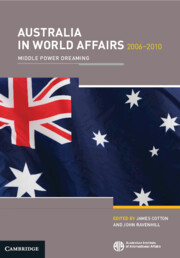Book contents
- Frontmatter
- Contents
- Tables, Figures and Boxes
- Contributors
- Preface
- Abbreviations
- 1 Middle Power Dreaming: Australian Foreign Policy during the Rudd–Gillard Governments
- 2 The Howard–Downer Legacy: Global Deputy, Regional Sheriff
- 3 Back from the Brink: Australia and the Global Economy 2006–10
- 4 Australia–America 2006–2010: Waiting for Obama
- 5 Australia and China: The Challenges to Forging a ‘True Friendship’
- 6 Australia and Japan: Mobilising the Bilateral Relationship
- 7 Australia and Europe
- 8 Australia’s Strategic and Commercial Engagement with South Asia under Kevin Rudd: The Paradoxes
- 9 Australia, the Pacific Islands and Timor-Leste
- 10 Progress and Limits in Regional Cooperation: Australia and Southeast Asia
- 11 Australian Foreign Policy towards Africa
- 12 Plus Ça Change? The Coalition, Labor and the Challenges of Environmental Foreign Policy
- 13 The Australia 2020 Summit as an Experiment in Foreign Policy-making
- 14 Defence and Security
- 15 Australia’s Foreign Policy Machinery
- 16 Regional, Alliance and Global Priorities of the Rudd–Gillard Governments
- References
- Index
8 - Australia’s Strategic and Commercial Engagement with South Asia under Kevin Rudd: The Paradoxes
Published online by Cambridge University Press: 04 May 2024
- Frontmatter
- Contents
- Tables, Figures and Boxes
- Contributors
- Preface
- Abbreviations
- 1 Middle Power Dreaming: Australian Foreign Policy during the Rudd–Gillard Governments
- 2 The Howard–Downer Legacy: Global Deputy, Regional Sheriff
- 3 Back from the Brink: Australia and the Global Economy 2006–10
- 4 Australia–America 2006–2010: Waiting for Obama
- 5 Australia and China: The Challenges to Forging a ‘True Friendship’
- 6 Australia and Japan: Mobilising the Bilateral Relationship
- 7 Australia and Europe
- 8 Australia’s Strategic and Commercial Engagement with South Asia under Kevin Rudd: The Paradoxes
- 9 Australia, the Pacific Islands and Timor-Leste
- 10 Progress and Limits in Regional Cooperation: Australia and Southeast Asia
- 11 Australian Foreign Policy towards Africa
- 12 Plus Ça Change? The Coalition, Labor and the Challenges of Environmental Foreign Policy
- 13 The Australia 2020 Summit as an Experiment in Foreign Policy-making
- 14 Defence and Security
- 15 Australia’s Foreign Policy Machinery
- 16 Regional, Alliance and Global Priorities of the Rudd–Gillard Governments
- References
- Index
Summary
In the early 1990s, scholars talked about Australia’s neglect of South Asia, in particular Australia’s failure to understand the rising importance of India. We spoke of indifference, blind spots, missed opportunities, general indifference and even ideological differences between the two countries that began with Jawaharlal Nehru and Sir Robert Menzies. During the last ten years, Australia’s engagement with South Asia has changed dramatically – Australia has been involved in a counterinsurgency war against the Taliban in Afghanistan intermittently since 2002, and India has emerged as Australia’s fourth largest export market. The paradox that this chapter addresses is the way in which Australia’s strategic engagement with South Asia was dominated by Afghanistan while Australian commercial national interests lay with India. These two relationships have overwhelmingly defined Australia’s connection with South Asia. The focus is on Kevin Rudd’s period as prime minister of Australia (2007–10) and his subsequent role as foreign minister (from 2010), because the Rudd years capture the essence of Australia’s new relationship with this part of the world where some two billion people live.
Keywords
- Type
- Chapter
- Information
- Australia in World Affairs 2006–2010Middle Power Dreaming, pp. 112 - 126Publisher: Cambridge University PressFirst published in: 2024

